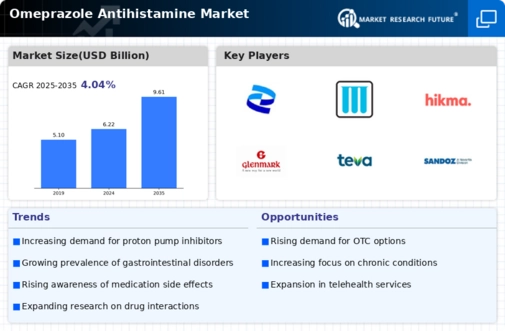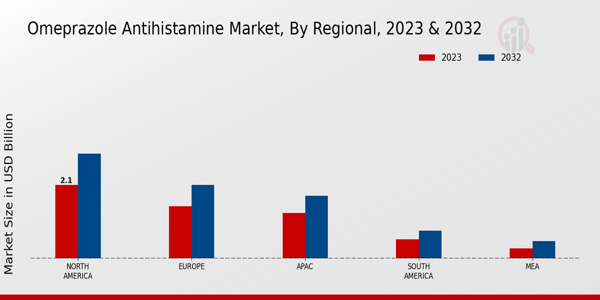Aging Population
The aging population worldwide significantly influences the Global Omeprazole Antihistamine Market Industry. As individuals age, they are more susceptible to gastrointestinal disorders, including acid reflux and peptic ulcers. This demographic shift results in an increased demand for medications like omeprazole, which effectively manage these conditions. By 2035, the market is expected to reach 9.61 USD Billion, reflecting the growing need for effective treatments among older adults. Furthermore, healthcare providers are increasingly focusing on preventive measures, which may lead to higher prescription rates of omeprazole, thereby enhancing market growth.
Market Growth Projections
The Global Omeprazole Antihistamine Market Industry is projected to experience substantial growth over the coming years. With a market value anticipated to reach 9.61 USD Billion by 2035, the industry is poised for expansion driven by various factors. The compound annual growth rate (CAGR) of 4.04% from 2025 to 2035 suggests a steady increase in demand for omeprazole-based antihistamines. This growth trajectory reflects the ongoing need for effective treatments for gastrointestinal disorders, as well as the potential for new product developments and market entrants to further stimulate the industry.
Growing Awareness and Education
There is a notable increase in awareness and education regarding gastrointestinal health, which positively impacts the Global Omeprazole Antihistamine Market Industry. Public health campaigns and educational initiatives are informing patients about the symptoms and treatment options for acid-related disorders. This heightened awareness encourages individuals to seek medical advice and treatment, leading to an uptick in prescriptions for omeprazole. As patients become more informed about their health, the demand for effective antihistamines is likely to rise, contributing to the overall growth of the market. This trend indicates a proactive approach to managing gastrointestinal health.
Increasing Healthcare Expenditure
The rise in global healthcare expenditure is a crucial driver for the Global Omeprazole Antihistamine Market Industry. Governments and private sectors are investing more in healthcare, leading to better access to medications and treatments for patients. This trend is particularly evident in developing countries, where healthcare reforms are underway to improve access to essential medicines. As healthcare spending increases, the availability of omeprazole and related antihistamines is likely to improve, thereby boosting market growth. Enhanced healthcare infrastructure and insurance coverage also contribute to higher prescription rates, further supporting the market's expansion.
Advancements in Pharmaceutical Research
Innovations in pharmaceutical research and development are propelling the Global Omeprazole Antihistamine Market Industry forward. Ongoing studies into the efficacy and safety of omeprazole, along with the development of new formulations, are likely to enhance its therapeutic profile. These advancements may lead to improved patient adherence and satisfaction, which could result in a compound annual growth rate (CAGR) of 4.04% from 2025 to 2035. As new delivery methods and combinations with antihistamines emerge, the market is poised for expansion, catering to diverse patient needs and preferences.
Rising Prevalence of Gastroesophageal Reflux Disease
The increasing incidence of gastroesophageal reflux disease (GERD) globally drives the demand for the Global Omeprazole Antihistamine Market Industry. As lifestyle changes and dietary habits contribute to the rise of GERD, the need for effective treatment options becomes paramount. Omeprazole, a proton pump inhibitor, is often prescribed to manage this condition, leading to a projected market value of 6.22 USD Billion in 2024. The growing awareness of GERD and its complications further fuels the market, as patients seek relief from symptoms, thereby expanding the consumer base for omeprazole-based antihistamines.





















Leave a Comment